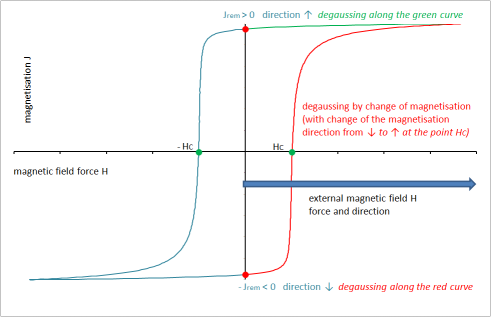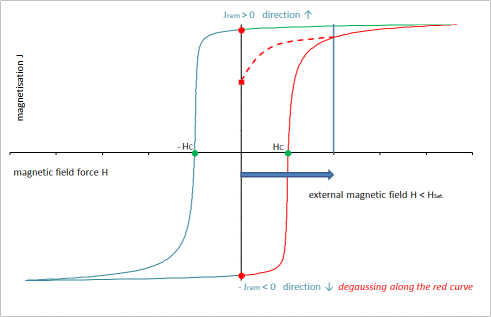Erasing magnetically recorded Data
Characteristic values of hard magnetic materials used in storage media are
- the size of their coercivity Hc
- the size of their remanent magnetisation Jrem
Both properties are measured after a previous magnetisation to the magnetic saturation Jsat .
The size of the coercivity Hc is important for the conservation of the recorded data and for the preventative of unintentional deletions / changes by superimposed magnetic fields.
A high remanence Jrem is decisive for a strong reproducing signal and thus for a clear readability of the stored data.
In the following diagram are represented
- J(H)-magnetisation-characteristic
- J(H)-hysteresis-loop
of a ferro-magnetic material.
(The loop was not measured at a hard magnetic disc. For data storage, a rectangular shape of the loop is preferred.)

For the magnetic recording of data smallest volumes of the magnetic layer are sequentially magnetised. Their magnetic moments m = {Jrem * V} are aligned or arranged according to a specific code in parallel or anti-parallel.
That stored data are erased by an external field Ha if all these magnetic moments m = {Jrem * V}
- are forced in the same direction/ orientation and
- are approximately equal.
This is shown in the next picture by the example of volumes V with antiparallel magnetic moments.
Their magnetic initial state with the different remanent magnetisations {Jrem} and {-Jrem} is characterized by red dots.
The magnitude and direction of the external field Ha are represented by the blue arrow.

Effect of the magnetic field on volumes with remanence {Jrem} > 0:
The magnetisation changes are described by the green loop section.The volumes of interest are magnetised in their initial state in direction of the external field Ha.
They are more magnetised by this field Ha to the end point of the loop with the value J ≈ Jsat
If the external field is returned to the value Ha = 0, the magnetisation J returns to the original remanence {Jrem}.
Effect of the magnetic field on volumes with remanence {Jrem} < 0:
In this case the magnetisation changes are described by the red loop section.
The magnetic moments m = {Jrem * V} of these volumes are directed against the external field Ha. in the initial state. This remains up to the coercive field Hc. Above this value, the direction change takes.
Then these volumes are magnetised by the field Ha along the red loop section to the endpoint of the J(H)-loop .
Changes of magnetisation by the magnetic field
Both volumes are equal after magnetisation by the magnetic field Ha and have got the same value {Jrem} > 0 (= upper red dot).
They can not be discriminated from each other, they do not store any information.
The procedures are illustrated schematically in the following diagram.

Criteria for a complete erasure of magnetically recorded data
For a total erasure of magnetically stored data the used field strength Ha has to be stronger than the saturation strength Hsat of the hardmagnetic layer.
The saturation field strength Hsat is required for achieving the (material-specific) saturated magnetisation Jsat .
In the case of a rectangular shape of a J(H)-loop
- the saturation field strength Hsat and the coercive force Hc
- the corresponding remanent magnetisations J(Hsat) rem and J(Hc)rem.
approach each other.
The erasure of data is not complete, if the magnetic field Ha is greater than the coercive force Hc and smaller than the saturation strength Hsat of the material of hard magnetic layer. In this case
- all magnetic moments {Jrem*V} have the same direction
- the amount of the remanence {Jrem} depends on the initial magnetic state.
This is shown in the next picture.

Such differences in the remanent magnetisations Jrem are detected in an atomic force microscope MFM (MFM = magnetic atomic force microscope ) and marked as non-unique data erasure.
If in the read-write head only a field strength Hread-write-head < Hsat below the saturation field strength Hsat is reached, for a safe data erasure a field force Ha ≥ Hread-write-head f would be sufficient. One assumes generally Hread-write-head ≥ Hsat is valid.